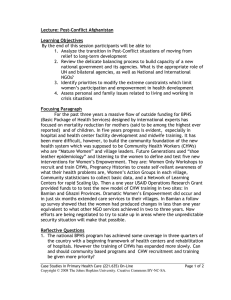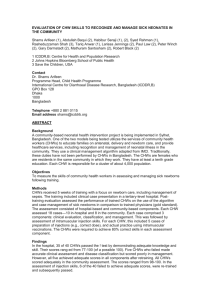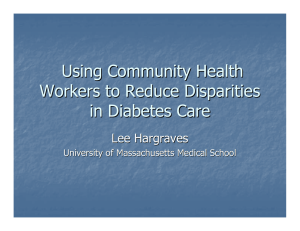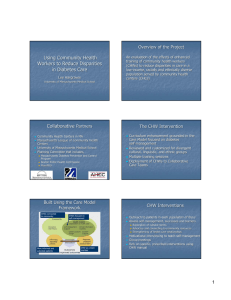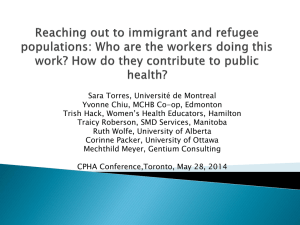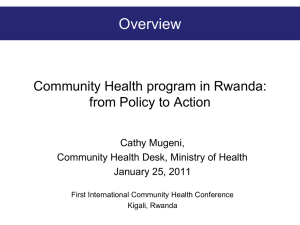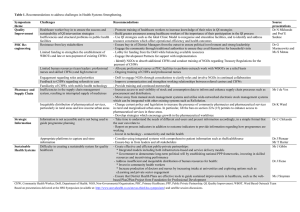Using Community Health Workers to Reduce Disparities in Diabetes Care
advertisement
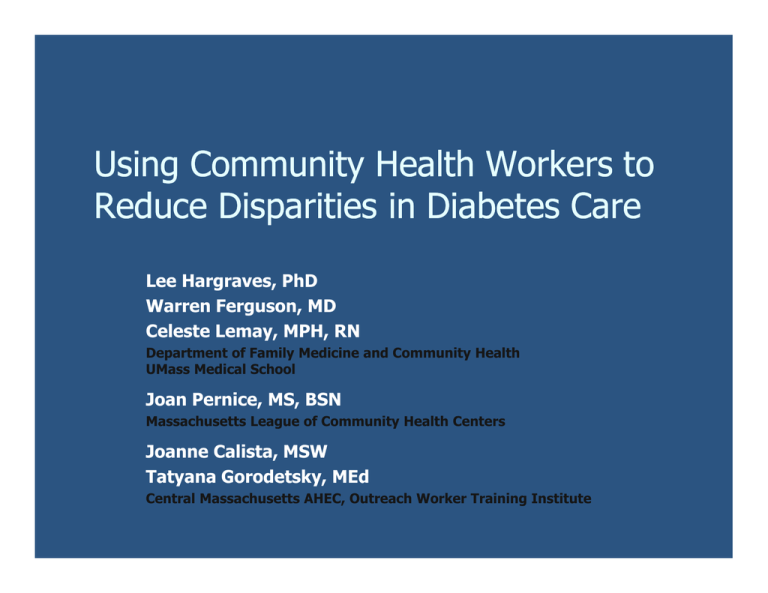
Using Community Health Workers to Reduce Disparities in Diabetes Care Lee Hargraves, PhD Warren Ferguson, MD Celeste Lemay, Lemay MPH, MPH RN Department of Family Medicine and Community Health UMass Medical School Joan Pernice,, MS,, BSN Massachusetts League of Community Health Centers Joanne Calista, MSW atya a Gorodetsky, Go odets y, MEd d Tatyana Central Massachusetts AHEC, Outreach Worker Training Institute Partners Partners Massachusetts League of Community Health Centers University of Massachusetts Medical School Outreach Worker Training Institute off C Central t l Mass M AHEC Support S ppo t Robert Wood Johnson Foundation Finding Answers: Disparities Research for Change Commonwealth Medicine, University of Massachusetts Medical School Backg o nd Background Community Health Workers (CHW (CHW’s) s) have gained prominence as members of the health care workforce Working in communities of racial and ethnic th i minorities, i iti serving i as liaisons li i between individuals & the health care system In diabetes care the reported p effectiveness of CHWs on health behaviors are mixed Comm nit Health Workers Community Wo ke s Provide culturally appropriate health education and information Assist people getting health services Provide social support to vulnerable populations Advocate for communities and individuals Often hired specifically for their understanding of diverse populations Built Using the Care Model Framework Self--Management Self The Chronic Care Model provides a model to support patients living with a chronic health condition to manage their disease Requires q collaboration between patients p & health care professionals Interrelationship of self self--management, management patient--physician communication, and patient adherence are well documented Goals of Project Train CHWs in Diabetes SelfSelf-Management in the context of the Chronic Care Model Patients receiving care from trained CHWs will: Have success with selfself-management Have improvements in managing diabetes and reducing cardiovascular risk Intervention Six pairs of community health centers, centers Matched to be similar in size, racial and ethnic populations served, and performance in Phase 1 of a statewide disparities collaborative were Randomized to an intervention of enhanced patient support by CHWs Implementation Developed 45 45--hour CHW Diabetes SelfSelfmanagement Certificate Course Curriculum CHWs received training from March 2007 through May 2007 Supervisors received training in May 2007 Curriculum Development 45-Hour 45H CHW C Certificate tifi t Course C Core Competencies + Diabetes and Self Self-Management Management Support 1. Service Coordination Skills 2. Interpersonal Skills 3. Communication & Interviewing g Skills 4. Organizational Skills 5. Presentation & Facilitation Skills 6. Advocacy and Leadership Skills 7. Cultural Awareness & Sensitivity Skills 8. Diabetes management and support Implementation (continued) CHWs working in health care teams within the health centers from June 1, 2007 through June 30, 2008 Ongoing CHW Training utilizing conference calls or workshops every 6 weeks CHW and patient interaction data collected utilizing an Encounter Form Data Collection Quantitative Encounter Form P Population l ti off F Focus P Patient ti t R Registry i t (i.e., PECS; EMR) Clinical process/outcomes (e.g., (e g HbA1c, HbA1c LDL) of ~100 patients/health center Qualitative Interviews with CHWs and Supervisors The Encounter Form One page long Includes type/length of contact Check list of activities Self--management Self g goal g setting g Patient’s confidence in SMG The Encounter Form Self--Management Behaviors Self Ask the patient: On how many of the last seven days…. Have you followed a healthful eating plan? Did you do at least 30 minutes of physical activity Did you test your blood sugar? Did you check your feet? Did you take your diabetes medicine? The Encounter Form Identified Self Self--Management Goal: What? When? Where? How often? f Patient Demographics Patient Characteristics Number of Patients Enrolled Mean Age in years (st err) Gender Male Female Ethnicity Latino Black, non‐Hispanic White, non‐Hispanic Others Missing Insurance Public Private Others Uninsured Unknown Community Health Center y by‐Community Health Worker Random Assignment No CHWs CHWs 921 494 52.5 (13.0) 54.9 (14.0) 449 (48.7%) 231 (46.8%) 472 (51.3%) 263 (53.2%) 241 (26.2%) 125 (25.3%) 182 (19.8%) 60 (12.2%) 327 (35.5%) 260 (52.6%) 82 (8.9%) 37 (7.5%) 89 (9.7%) 12 (2.4%) 449 (48.9%) 308 (62.4%) 129 (14.08%) 56 (11.3%) 125 (13.6%) 69 (14.0%) 192(20.9%) 58 (11.7%) 26 (2.8%) 3 (0.6%) Results: Encounter Forms Between June 2007 and June 2008: 1198 Encounters with 540 patients in 6 community it health h lth centers t 724 Encounters E t with ith 288 (58%) patients ti t living li i with diabetes in the population of focus 474 Encounters with 252 patients not in the population p p of focus Results: Encounter Forms Most occurred individually, individually either over the phone (49%) or face face--to to--face (44%) The majority (83%) of Encounters lasted 30 minutes or less 69% of Encounters included recording or discussing d a selfself lf-management goall Example of SM Goal: Goal: Diet pt added more leafy greens to his diet.. diet Continued focus as before. pt will follow a strict healthful plan p p everyy day at each mealtime. Pt works @ McDonalds and he will try to d decrease the th carbs b intake. i t k Example of SM Goal: Exercise Pt will walk around his house, house 7 days a wk for 15 min. Exercise at the Gym/Walk at the mall everyday AM & PM Exercise/walking while running errands in the neighborhood once/day once/day.. Example of SM Goal: Blood Glucose Monitoring After a third time on glucometer teaching feels confident doing FSBS. Pt has not seen a doctor over a year* Pt will start FBSB twice a day, fasting Pt glucometer has been broke for 2 months, has not ck blood sugar. Pt given Rx Example of SM Goal: Checking Feet 1. Check feet at night daily. g , drink soyy milk 2. Diet - will eat vegetables, check feet in a.m and after shower at home x2/day. x2/day Results: Encounter Forms Five Most Common SMG N=752 30% 25% Percent 25% 24% 21% 20% 15% 15% 10% 5% 5% 0% Keeping/Scheduling Appt Monitoring blood sugar Modifying diet Exercising Adhering to medication Results: Encounter Forms Percent Five Most Common Educational Strategies N=1198 45% 40% 35% 30% 25% 20% 15% 10% 5% 0% 39% 29% 21% 19% 13% General diabetes information Healthful eating strategies Exercise strategies Glucose testing strategies Medication Adherence strategies Results: Encounter Forms For patients who had more than one encounter & completed the Diabetes SelfSelfCare Activities at 2 or more visits (N=171): Patients reported an increase in the number of days that they have checked their feet Pre: mean of 3.7 3 7 days vv. Post: 4.8 4 8 days, days p=.001 001 Results: Encounters and Self Management Goals CHWs were more likely to have encounters with patients who had been seen in the health center once a year in the previous 3 years Patients at centers with a CHW were more likely to have a documented Self Self-Management Goal than patients receiving care at control sites Percentage of Patients with Documented SMG in Past Year * * * * P < 0.05 Community Health Workers No Community Health Workers Self-Management Goals at SelfHealth Centers with CHWs Percentage change SMG setting before and after by Race/Ethnicity Latino 45 to 51% + 6% p < 0.001 Black, nonnon-Hispanic 50 to 76% + 26% p = 0.01 White, nonnon-Hispanic 44 to 62% + 18% p < 0.001 Note: Results from a multivariable model that included age, gender, number of visits, and clustering of patients within community health centers (GEE model) Self-Management Goals Selfat CHCs without CHWs Percentage change SMG setting before and after by Race/Ethnicity Latino 37 to 34% -3% n.s Black, nonnon-Hispanic 20 to 22% + 2% n.s.. n.s White, nonnon-Hispanic 24 to 19% - 5% n.s Note: Results from a multivariable model that included age, gender, number of visits, and clustering of patients within community health centers (GEE model) Percentage of Patients with Documented LDL in Past Year Community Health Workers No Community Health Workers Percentage of Patients with Documented HbA1c in Past Year Community Health Workers No Community Health Workers Percentage of Patients with HbA1c < 8 in Past Year Before After 100% 90% 80% 70% 60% 50% 40% 30% 20% 10% 0% Community Health Workers No Community Health Workers Interviews Inte ie s and Focus Foc s G Groups o ps CHWs Focus Groups: 6 weeks after deployment p y At conclusion of intervention S Supervisors: i Interview 6 weeks after deployment Focus Group at conclusion of intervention Conclusions Concl sions Ongoing training and contact decreased issues and problems with burnout as all CHWs remained with the p project j Utilizing an Encounter Form was an effective tool for collecting g data related to CHWs’ work CHWs can be effective in assisting patients to set selfself-management goals, a first step in the path to behavior change One year is a very short time period to improve patient outcomes related to diabetes and CVD Policy Polic Sustainability of community health workers is problematic, particularly in difficult economic times CHWs can be a valuable member of the health care team,, especially p y for populations p p with chronic health conditions Continue to investigate the CHW role in assisting to build the medical home
